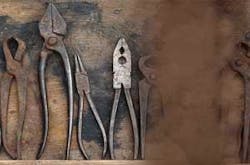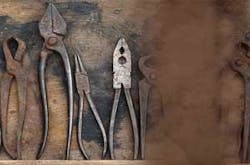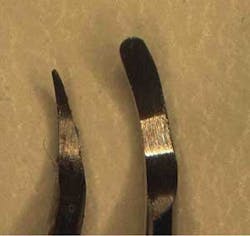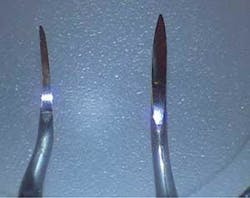Instrument Replacement: How, When, & Why?
Understanding the why, when and how of instrument replacement will be useful when assessing dental hygiene instruments.
by Jodie Heimbach, RDH, and Cheryl A. Thomas, RDH
A Call For Help
I was recently asked to substitute at a nearby dental office for a dental hygienist who was on vacation. It was for a doctor that I knew who has a reputation for high quality dentistry. I was honored to help out. I showed up that morning ready to go. I opened the first pack of instruments and thought, "Hmmm, these must be their old ones." I started looking through the drawers and saw nothing better.
I wasn"t sure how I could make it through the day. How could I do a good job with no cutting edges on any of the instruments? I soon realized I would just have to do the best possible job under the circumstances.
I strive to be a high quality RDH and I know the value of sharp and well-maintained instruments; however, situations such as these may compromise my reputation and more importantly, patient care.
When should dental hygiene instruments be replaced?
Sincerely,
Concerned Caregiver, RDH
When readers carefully examine the author's dilemma, they will agree that Concerned Caregiver is at a disadvantage. Not having adequate equipment is a challenge. To make matters worse, the author is working in an unfamiliar atmosphere.
Hopefully, this clinician had access to a well-maintained ultrasonic or piezo unit, which is now known as the preferred method of biofilm disruption. Still, there are times when we must rely on hand instruments, and we share the author's concerns. In a temporary or fill-in position, clinicians lack time or rapport with the office team to rectify the situation. However, many clinicians experience similar circumstances even in their permanent positions. Understanding the why, when, and how of instrument replacement will be useful when assessing dental hygiene instruments.
Why?
A scaler or curette that is in poor condition may fail to detect calculus, or even fail to remove it as tactile sensitivity is reduced. When using malformed instruments, the reduction in tactile sensitivity will cause the clinician to use more lateral pressure when scaling, which may lead to patient discomfort, operator fatigue, and inadvertent slipping of the instrument. Dull instruments create stress on the clinician's hands, wrists, arms and shoulders. The greater force exerted while using dull instruments is more likely to cause carpal tunnel syndrome compared to the number of repetitions.
Obviously, work time is increased as the effectiveness of an instrument is decreased. An instrument in poor condition may damage the root surface or cause the operator to burnish calculus, which makes it even more difficult to remove. There is also the risk of breaking the tip of the instrument off in the patient's sulcus when the blades are too thin. Using instruments that are not in ideal condition can be compared to "cutting steak with a butter knife."
When?
Because dull, worn, and damaged scalers and curettes are harmful to patients and clinicians, this checklist of the criteria for retiring and maintaining instruments will benefit your practice.
Maintenance Criteria For New Instruments
- Confirm that you have received the instrument you ordered before opening. (Most manufactures will not accept returns after the package has been opened.)
- Visually inspect each instrument for defects.
- New instruments are not sterile. Be sure to autoclave each instrument before using.
- Custom instrument identification or color-coding instruments can save valuable time. Not only can you group them in kits, you can also add a second code to help track the date the instrument was purchased. This can be beneficial in two ways. You can track how long your instruments are lasting, and you can quickly identify newer kits for heavier cases.
- Be sure to have an adequate number of instruments. If you see eight patients a day, you should have eight complete setups in your armamentarium. This ensures you can offer services throughout the day without interruption (malfunction or broken autoclaves), and that the lifespan of your instruments will be extended.
Maintenance Criteria For Existing InstrumentsCleaning and Sterilization:
- Inspect each instrument for debris. This is not only for infection control — remaining debris can cause corrosion.
- All instruments should be ultrasonically cleaned with a non-corrosive, low suds, neutral enzymatic detergent which eliminates hand scrubbing, which therefore reduces the chance of injuries.
- If it is not possible to place instruments in the ultrasonic immediately, a presoak is recommended.
- To get the most life out of your instruments, always follow the manufacturer"s recommendations for care, sterilization, and maintenance.
- Instruments must be totally submerged in the ultrasonic or presoak.
- Using a cassette (instrument maintenance system) increases the lifespan of your instruments by keeping them from bouncing against each other during cleaning and sterilization, and keeping them in easy order for inspection.
Inspection:
- Inspect each instrument before every use for signs of corrosion, cracks, dull edges, worn/thin blades, bent, or broken tips.
- Evaluate for sharpening before each use. We suggest visually examining the blade and biting into a test stick.
Sharpening:
- Sharpen at the first sign of dullness. If you wait too long, more metal will be removed, decreasing the lifespan of the instrument.
- When a dull instrument is held under light, the rounded surface of its cutting edge reflects light back to the observer. When a sharp instrument is held under a light, no bright reflection can be observed.
- Development of sharpening skills require patience and practice, and clinical excellence cannot be attained without it.
- If you are uncomfortable manually sharpening instruments, there are other options, including a power sharpener with easy guides that give you the correct angulation to maintain blade shape, or a stone with manual guides, which also help you keep the proper angulation when sharpening.
- Use loupes and illumination for a better visual inspection and when sharpening to maintain the proper form of the instrument.
Expected instrument lifespan:
- If 20 percent of the instrument blade width or length is reduced, it is time to retire the instrument.
- The average life of an immunity steel scaler or curette is six to 12 months vs. the average life of an instrument made of emerging metal technology, which should last an average of 15 to 18 months.
- There are many variables that may affect the lifespan of instruments.
- Use instruments only for their intended use. For instance, don"t use your scaler to open toothbrush packages, etc.
Retipping:
- Retipping is no longer supported as it may lead to tip loss, cracks in the handle, lack of balance, and wear due to inferior steel. Another disadvantage of retipping is the time involved requiring more instruments to be available while others are out for retipping.
Green Hygiene:
- Now that you know which of your instruments should be retired, what will you do with them? Many manufacturers have "green" programs for recycling old instruments. Some even provide mailing cartons and have incentives (for example, one free instrument for every 12 recycled). Check with individual companies for their recommendations and procedures regarding recycling.
Negotiating For New Instruments – How?
Now that you know the why and when, let's talk about the "how." Knowing when and why to replace dental hygiene instruments is important to clinical expertise. However, communicating these needs may be the biggest challenge all. Success will depend on many factors, including your reputation, the amount of time you've been employed in the practice (as well as your expected remaining time), and your business skills. Employers respect a healthy symphony of clinical skill and business savvy.
The following tips will assist you when you negotiate for new instruments:
- Reputations start at the front door and are a forever changing projection of you.
- Choose your attitude! Attitude decides if you show up to work on time or if you're dying to sneak out the door early. What"s more, your attitude reaches well beyond your front door. How you feel about your office is evident within the community. The pride you do (or don't) have is a materialization of excellence (or not). Naturally, employers that are driven to provide quality care will seek employees with similar objectives, and the same can be said of those who are not. Therefore, the image you project is not only a projection of your employer, it is a projection of you.
- Personal appearance. A pressed uniform sends the message that you care about your professional image. It is an expression of your happiness and dedication in both your professional and personal life. Although your employer may not address wrinkled scrubs and unkempt hair, he or she does notice it.
- Do you complain or are you a problem solver? If you identify a problem in the workplace, be willing to make two realistic suggestions on how to improve the problem.
- Pay attention during staff meetings. Be prepared. Bring a pen, notepad, and your ideas. Are staff meetings boring or confrontational? Offer to present information about a new material or procedure, or offer to help with the meeting so it will be enjoyable.
- Step out of your comfort zone. Prepare a plan to help the practice build stronger relationships with your referral sources. Develop a better tracking system for your production or share ways you're investigating to increase production.
- Document your progress with facts and figures. Cold, hard data is the perfect way to show trends that demonstrate that what you're doing is working.
- Be the source. Collect and organize evidence-based research from dental and dental hygiene journals. Conduct and document your own research within the practice. Let's say you want to try a new product – keep track of it (efficacy, patient critiques, etc.). Record the data and share the results.
Negotiate an annual budget for instruments and equipment that you will use at the office. During the interview process, it is critical for you to accept a position in an office that has the same practice goals and values as yourself. If you're already employed and haven't negotiated an annual budget, don't worry – do your homework and set realistic goals and present them in a concise manner. Remember to address concerns you think the employer may have. Focus on their top priorities, i.e., what will it cost, how will the practice benefit, and if you leave the practice in six months will your replacement be able to utilize the expenditure? Look for technology that can extend the life of your instruments. Are you fully utilizing ultrasonic or piezo technology?
Consider joining Toastmasters International. OK, so you don't want to be a public speaker. Toastmasters is a forum used by many in the business world to develop skills to present ideas in a clear and concise manner. Toastmasters is a self-paced program that teaches participants how to communicate in the business world more effectively, increase their leadership potential, build their ability to motivate and persuade, reach their personal and professional goals, and become more self confident. Visit Toastmasters at http://www.toastmasters.org/.
It's very easy to set yourself on "autopilot" and believe you'll always be in the office you are today. The reality is that nothing lasts forever. Life happens and employees in every job market leave. When negotiating for equipment, remember it is a real concern for employers. Explore alternatives that are mutually beneficial.
In order to maximize the possibility of a positive resolution, be a good listener. Expect a positive resolution when a difference of opinion occurs. If you've made a request that's denied, don't be afraid to ask why in a non-confrontational and supportive manner. The reason might be something that can be negotiated.
If there is a confrontation within the office, keep your composure. Don't respond with anger, but rather evaluate the situation. Is the anger actually directed toward you? Are you in a position to solve the problem? Is this a new or ongoing problem? This is where being a problem solver will make you valuable to the practice.
There is a hierarchy in all aspects of our lives, including our place of employment. Build positive relationships and learn to navigate the system without stepping on toes.
Keep in mind it isn't only what you know – it's how you communicate what you know! Resist becoming jaded – expect positive outcomes and learn how to communicate your needs effectively. Present your requests with facts, not feelings, and have a sound business plan. Keep in mind the rationale for replacing instruments and refer often to the criteria for replacement. Providing superior clinical care to patients cannot be our sole perspective. Rather, finding a healthy balance between clinical care and business savvy creates an environment that is beneficial to everyone.
About the Authors
Jodie Heimbach, RDH, is a 1977 graduate of Fones School of Dental Hygiene and has been practicing clinical dental hygiene for 30 years. For the last five years she has worked in a periodontal practice in Ocean, NJ. Jodie is involved in two dental hygiene study clubs and is active in her local component. Jodie has plans to educate dental professionals on the importance of working with well-maintained instruments. She resides in Howell, NJ, with her husband and two daughters. You can contact Jodie at [email protected].
Cheryl A. Thomas, RDH, currently resides in Galveston, Texas. She can be contacted at [email protected], or visit her Web site at dentalinspirations.org.



